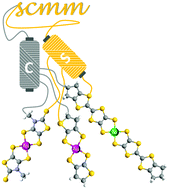The quest for single component molecular metals within neutral transition metal complexes†
Abstract
Twenty years ago, the molecular materials community accomplished a major breakthrough with the report of the first single component molecular metal (SCMM). Previously it was believed that molecular metals had to be composed of a pair of partially oxidized species, a condition necessary to guarantee the formation of the conduction band and the generation of charge carriers. However, by the turn of the millennium a new paradigm arose with the discovery of metallic behaviour in two neutral complexes, [Ni(tmdt)2] (tmdt: trimethylenetetrathiafulvalenedithiolate) and [Au(α-tpdt)2] (α-tpdt: 2,3-thiophenedithiolate). Since then, this topic gathered the attention of the scientific community and the number of available SCMM in literature consequentially increased. By their nature, neutral bis(1,2-dithiolene) and bis(1,2-diselenolene) transition metal (BTM) complexes still remain, by far, the best candidates to obtain a SCMM. This review will focus on these materials, their design, synthesis, and properties. Based on their molecular-crystal-band structures, an analysis of the requirements to prepare a SCMM, will also be address.

- This article is part of the themed collection: Materials for molecular electronics and magnetism


 Please wait while we load your content...
Please wait while we load your content...